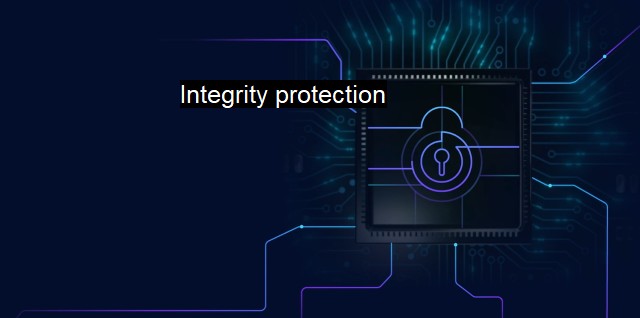What is Integrity protection?
Ensuring Trust and Accuracy: Understanding Integrity Protection in Cybersecurity and Antivirus
In the context of cybersecurity and antivirus measures, integrity protection encompasses a wide array of strategies and protocols that aim to ensure the consistency, accuracy, and trustworthiness of data throughout its entire life cycle. It focuses on preventing unauthorized modification, deletions, or additions to information stored, processed, or transferred from one system or place to another. Contrary to popular belief, the central concern of integrity protection does not purely revolve around the prevention of a data breach, rather it highlights safeguarding the data from unauthorized manipulation, thus securing the originality and correctness of the content.Utilizing the concept of integrity protection as its defense mechanism, antiviral software ensures data stability and serves to safeguard systems and networks from all forms of unauthorized modification. Such protective measures ensure that, in the occurrence of a successful cyber attack, the damage would be contained within fixed parameters, essentially limiting the capacity for further adverse modifications or exploitations of loopholes in the defenses. Consequently, the implementation of integrity protection mechanisms in antivirus software acts as a vital layer of security, supplementing preventative measures against malware intrusion, delivering a more holistic cybersecurity framework.
Primarily, integrity protection operates on two principles— prevention of improper alteration of data, and ensuring data is only modified by authorized users in an authorized manner. In the former, the data’s fidelity is maintained by preemptive measures that bar all forms of unsolicited alterations— made possible by the incorruptibility feature instilled by integrity safeguards. On the latter, the ability to differentiate between what is perceived as the “norm” and what seems like aberrant behaviors provides the surveillance capstone towards maintaining optimal defenses. Further consolidating this principle, advanced cybersecurity tools also substantiate on incident response maturity, ensuring an efficient and timely reaction to threat landscapes.
Intricately woven into the very defense fabric of most organizations, the importance of the integrity of data is a reflection of the latter's value in maintaining the seamless functionality of overall operations. On top of bolstering the established firewalls, effectively implemented integrity protection tools can further strengthen intranet ciphers while consistently ensuring systems’ protection from potential disruptions arising from internet-based threats.
It is noteworthy to mention that integrity protection is not solely targeted at securing business processes but its benefits traverse into protecting individuals as well. By maintaining the authenticity and veracity of data, users enjoy secured online experiences while confidently relying on the protection their antivirus software systems provide.
Constant evaluation and reevaluation of integrity protection tools are imperative to keep pace with the ever-evolving technology landscape. Coupled with technological advancements come increasingly sophisticated and elusive cyber threats, posing more intricate challenges to the cybersecurity sphere. As a result, it’s essential to constantly update systems, implement cutting-edge threat detection tools, and employ robust control processes to evaluate their effectiveness over time, thereby balancing accuracy and efficiency.
In the cybersecurity realm, integrity protection, traditionally seen as a core element of information security, lies as one of the three cornerstones of the CIA triad- Confidentiality, Integrity, and Availability. Thus, equally matching its peers, the discipline emphasizes not just safeguarding raw data but shielding the trustworthiness and reliability of system operations as well. Thus, it is clear that integrity protection plays an incredibly pivotal role in creating secure digital environments for businesses and individuals alike. After all, without the ease of mind that comes with knowing your data is not only secure but exactly as you left it, would we be willing to rely so heavily on digital systems and networks as we do now? Probably not. The answer underlines why integrity protection is so integral—at the end of the day, they’re not just protecting code or raw data; they’re protecting trust.

Integrity protection FAQs
What is integrity protection in cybersecurity?
Integrity protection is a security mechanism that prevents unauthorized changes to data or information during transmission or storage by ensuring that the information remains unaltered and only modified by authorized parties.How does integrity protection work in antivirus software?
In antivirus software, integrity protection is designed to prevent malware from modifying critical files or system components by frequently scanning these files and verifying their digital signatures, which ensures they have not been tampered with.Why is integrity protection important in cybersecurity?
Integrity protection is vital in cybersecurity as it ensures the confidentiality, availability and reliability of data, thereby reducing the risk of cyberattacks such as data tampering, modification or deletion.What are some common integrity protection techniques used in cybersecurity?
The common integrity protection techniques include digital signatures, access control mechanisms, firewalls, intrusion detection systems and secure protocols. Digital signatures use encryption to prevent unauthorized access or modification of data, access control mechanisms allow only authorized entities to access data, while secure protocols are used to ensure secure and reliable data transmission.| | A | | | B | | | C | | | D | | | E | | | F | | | G | | | H | | | I | | | J | | | K | | | L | | | M | |
| | N | | | O | | | P | | | Q | | | R | | | S | | | T | | | U | | | V | | | W | | | X | | | Y | | | Z | |
| | 1 | | | 2 | | | 3 | | | 4 | | | 7 | | | 8 | | |||||||